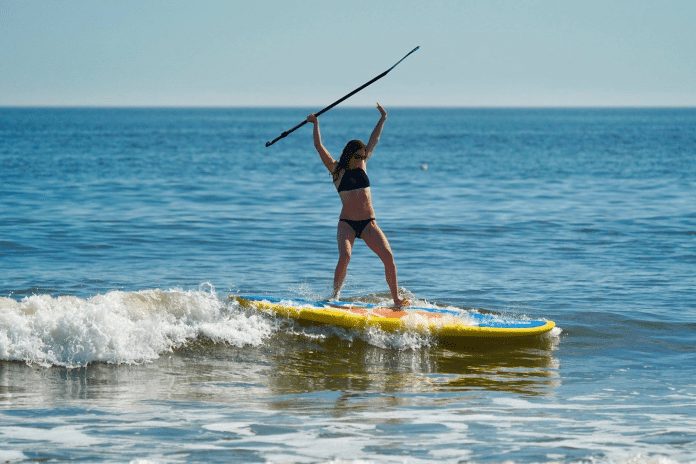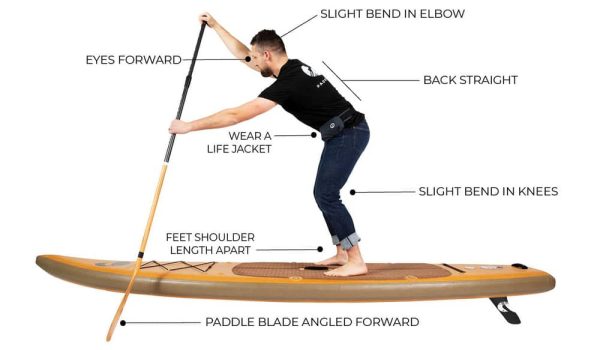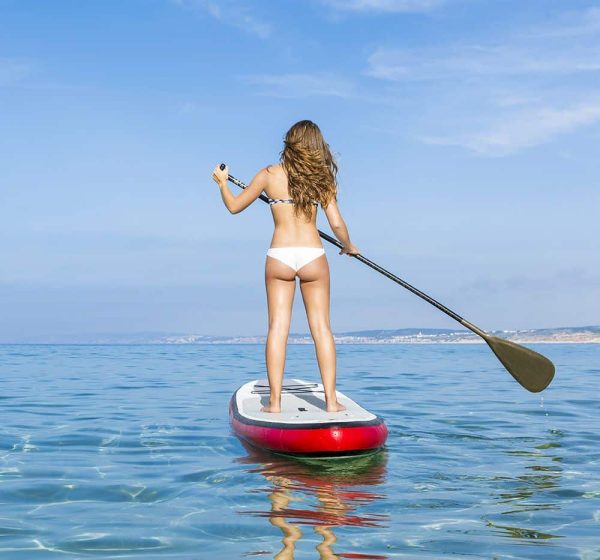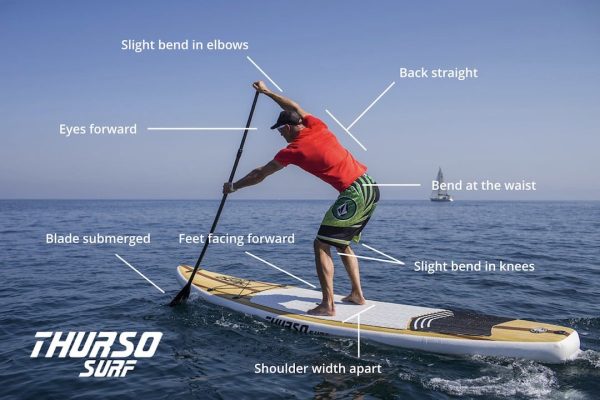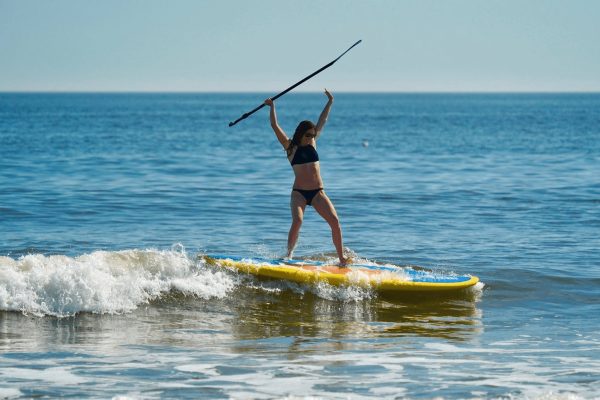Stand Up Paddle Boarding, or SUP for short, is a popular water activity that has gained momentum over the past decade. But have you ever wondered what the SUP board stands for?
In this article, we will unravel the mystery behind this trendy water sport and explore the origins of the acronym SUP. From its humble beginnings to its current status as a global phenomenon, join us as we uncover the fascinating story of SUP board and delve into the world of stand-up paddleboarding.
This image is the property of paddlenorth.com.
What Does SUP Board Stand For?
You’re in the right place if you’ve ever been curious about the acronym SUP board. SUP stands for Stand-Up Paddleboarding, a popular water sport involving standing on a large board and propelling yourself forward with a long paddle. In recent years, SUP boarding has gained immense popularity as a fun and accessible activity for people of all ages and skill levels.
Definition of SUP Board
Stand-Up Paddleboarding (SUP) Explained
Stand-up paddleboarding, or SUP for short, is a water sport involving standing on a large board and using a paddle to navigate the water. Unlike traditional surfing, where you lie on a board and ride the waves, SUP boarders stand upright and use their paddles to propel themselves forward. It offers a unique and exhilarating way to enjoy the water and explore various bodies of water, such as oceans, lakes, rivers, and even calm streams.
Understanding the Basics of SUP Boarding
As the name suggests, SUP boarding involves standing on a sturdy and stable board while using a paddle to navigate and propel yourself forward. The design of a SUP board allows for maximum stability, making it suitable for beginners and experienced riders alike. SUP boarding offers a versatile experience, as it can be enjoyed in different water settings, including water, open ocean, and even surfing waves.
History of SUP Boarding
Origins of SUP Boarding
The roots of SUP boarding can be traced back thousands of years to ancient Polynesia, where it was a standard mode of transportation and a sport known as “Hoe he’e nalu.” In ancient times, indigenous Polynesians used longboards and paddles to navigate the coastal waters for fishing, transportation, and recreational purposes. Although the modern version of SUP boarding has evolved, its origins lie firmly in the ancient practices of Polynesian voyagers.
Rapid Growth and Popularity of SUP Boarding
While SUP boarding may have ancient beginnings, its popularity in recent years has skyrocketed. The modern resurgence of SUP boarding is often credited to the surfing legends of Hawaii, who incorporated paddleboarding as an alternative way to stay fit and catch waves when the ocean was calm. Since then, the sport has caught on worldwide as people recognize the many benefits and enjoyable aspects of SUP boarding. It has become a global phenomenon attracting water enthusiasts of all ages.
Types of SUP Boards
All-Around SUP Boards
All-around SUP boards are versatile and suitable for various water conditions. They are designed to be stable and easy to maneuver, making them a perfect choice for beginners or those looking for a multipurpose board. Whether you want to cruise along calm waters, try a bit of surfing, or even practice yoga, an all-around SUP board can handle it all.
Touring SUP Boards
Touring SUP boards are specifically designed for more extended expeditions and adventures. With their sleek and streamlined shape, they excel in flatwater conditions, providing excellent glide and efficiency. Touring SUP boards are ideal for paddlers who enjoy exploring lakes, rivers, or coastlines for extended periods.
Fishing SUP Boards
Fishing SUP boards are specially designed to accommodate the unique needs of anglers. They have rod holders, tackle mounts, and additional storage options. Fishing SUP boards offer a stable platform from which fishermen can cast their lines, reaching fishing spots that are otherwise difficult to access from the shore.
Yoga SUP Boards
Yoga SUP boards are specifically designed for practicing yoga on the water. They offer a stable and non-slip surface, allowing practitioners to perform various yoga poses while floating on calm waters. Yoga SUP boards provide a unique and serene experience, combining the benefits of yoga with the tranquility of being on the water.
Surfing SUP Boards
Surfing SUP boards are shorter and narrower than other SUP boards, designed to handle waves and provide optimal maneuverability and responsiveness. With their increased rocker and sharp rails, surfing SUP boards allow riders to easily catch and carve waves. Whether you’re a seasoned surfer or a beginner looking to try something new, surfing SUP boards offers a thrilling and challenging experience.
Racing SUP Boards
Racing SUP boards are designed for speed and performance in competitive SUP races. They feature a long, narrow shape, minimizing water resistance and maximizing glide efficiency. Racing SUP boards are built with lightweight materials and often incorporate advanced designs to enhance their speed capabilities. These boards are tailored for experienced riders looking to challenge themselves and compete in the thrilling world of SUP racing.
This image is the property of www.shape.com.
Components of a SUP Board
Deck Pad
The deck pad, or traction pad, is the foam-covered surface on the board. It provides grip and traction, ensuring a firm and secure footing while paddleboarding. Deck pads are typically made from soft and comfortable EVA foam, which is water-resistant and provides a cushioned surface for your feet.
Leash
A leash is an essential safety accessory that attaches you to your SUP board. It is typically worn around the ankle or calf and ensures you stay connected to your board even if you fall into the water. Leashes come in various lengths and styles, designed to accommodate different types of paddleboarding.
Fin
The fin is a crucial component of a SUP board, as it helps with stability, tracking, and maneuverability. Most SUP boards have a single fin, although some models may feature two or three additional smaller fins, known as side fins. Depending on the board design and intended use, fins can be detachable or fixed.
Handle
The handle, often located in the center of the board, allows for easy transportation of the SUP board. It is typically made from sturdy materials such as nylon or rubber, providing a comfortable grip when carrying the board to and from the water.
Bungee System
Many SUP boards feature a bungee system with elastic cords or straps crisscrossing the deck. The bungee system provides a convenient storage solution, allowing you to secure personal belongings, such as a water bottle, backpack, or other essentials, to the board during your paddleboarding adventures.
Choosing the Right SUP Board
Considering Your Skill Level
When selecting a SUP board, it’s essential to consider your skill level and experience. Beginners will generally benefit from using broader and more stable boards, while advanced riders may prefer narrower and more agile boards. Finding a board that matches your skill level is crucial to ensure an enjoyable and safe experience on the water.
Understanding Board Dimensions
Board dimensions play a crucial role in determining a SUP board’s stability, maneuverability, and overall performance. A board’s length, width, and thickness can vary, and each dimension contributes to different aspects of the board’s performance. Longer boards offer better glide and tracking, while shorter boards enhance maneuverability and responsiveness. Wider boards offer excellent stability, while narrower boards excel in speed and agility.
Determining the Right Board Volume
Board volume refers to the amount of space the board displaces in liters, directly affecting its floatation and stability. The appropriate board volume depends on weight, skill level, and intended use. Generally, beginners and riders who prefer a more stable experience opt for boards with higher volume, while experienced riders may prefer boards with lower volume for increased maneuverability.
Identifying Suitable Board Designs
Different board designs cater to specific paddleboarding activities. Depending on whether you plan to explore calm waters, ride waves, or engage in other specialized activities, such as fishing or yoga, you’ll want to choose a board design that suits your preferences and desired water activities. It’s essential to consider the board’s shape, rocker profile, and overall design to ensure it meets your specific needs.
Considering Materials and Construction
SUP boards are typically constructed using various materials, such as epoxy, fiberglass, carbon fiber, and inflatable materials. Each material has advantages and considerations regarding weight, durability, and performance. Epoxy boards are famous for their versatility, while inflatable boards offer portability and easy storage. Understanding the different materials and construction methods will help you choose a SUP board that aligns with your priorities and preferences.
This image is the property of cdn.thursosurf.com.
How to Use a SUP Board
Gearing Up for the Adventure
Before setting off on your SUP adventure, you’ll need a few essential items to ensure a safe and enjoyable experience. These include a personal flotation device (PFD) or life jacket, appropriate clothing and footwear, sunscreen, a leash, and your SUP board and paddle. It’s important to dress appropriately for the weather and water conditions and bring any necessary equipment for any activities you plan to engage in while paddleboarding.
Basic Paddling Techniques
Learning the basic paddling techniques is essential for efficient and enjoyable SUP boarding. Proper paddling involves using your core muscles, engaging your whole body, and maintaining a stable stance on the board. You’ll maximize efficiency and minimize strain on individual muscles by engaging your core and using your legs, arms, and torso in sync.
Maintaining Balance
Maintaining balance on a SUP board is essential, especially for beginners or when paddling in challenging conditions. Keeping a firm and stable stance with your feet shoulder-width apart and your weight evenly distributed across the board will help you stay upright and steady. Relaxing and using your core muscles to maintain balance is essential, adjusting your body’s position and making subtle weight shifts.
Turning and Maneuvering
Learning to turn and maneuver your SUP board effectively adds to your overall paddleboarding experience. You can employ various techniques depending on the type of turn you want to execute and the conditions you’re paddling in. Pivoting turns, sweep strokes, and back paddling are just a few techniques to change direction and navigate your board smoothly.
Recovery Techniques
Falling into the water is all part of the paddleboarding experience, especially when starting. Knowing how to recover and get back on your SUP board quickly and safely is essential. By maintaining a calm and composed demeanor, using the leash to retrieve your board, and practicing proper body positioning, you’ll recover confidently and minimize the time spent off your board.
Benefits of SUP Boarding
Physical Fitness and Full-Body Workout
SUP boarding provides an excellent full-body workout, engaging various muscle groups simultaneously. Maintaining balance and propelling yourself through the water with your paddle requires the activation of your core muscles, arms, shoulders, and legs. Regular SUP boarding can help improve strength, endurance, and overall physical fitness.
Low-Impact Exercise
Unlike many high-impact sports, SUP boarding is a low-impact exercise that puts minimal strain on your joints. The buoyancy of the water reduces the impact on your feet, knees, and ankles, making it an ideal activity for those with joint sensitivities or injuries. SUP boarding allows you to enjoy a fun and challenging workout without the risk of excessive wear and tear on your body.
Improves Mental Health
Being out on the water and surrounded by nature provides a sense of tranquility and peace, which can positively impact mental health. SUP boarding allows you to disconnect from your daily stresses and immerse yourself in the beauty of your surroundings. The rhythmic motion of paddling, combined with the therapeutic effects of nature, can help reduce anxiety, improve mood, and promote overall mental well-being.
Connection with Nature
SUP boarding offers a unique perspective on the natural world as you glide across the water’s surface. It allows you to explore and appreciate the natural beauty of your surroundings, whether it’s a serene lake, a picturesque coastline, or a vibrant coral reef. Connecting with nature through SUP boarding can foster a deeper appreciation for the environment and motivate individuals to become better stewards of our waterways.
Accessible Water Sport for All Ages and Skill Levels
One of the most significant aspects of SUP boarding is its accessibility. Whether you’re a complete beginner or an experienced water enthusiast, SUP boarding can be enjoyed by people of all ages and skill levels. The versatility of SUP boards makes it easy to find a suitable board for individuals with varying abilities and preferences. It’s a fantastic activity for families, groups of friends, or even solo adventurers looking for a new and exciting way to spend time on the water.
This image is the property of images. Surfers. Art.
Safety Tips for SUP Boarding
Wearing a Personal Flotation Device (PFD)
Safety, including SUP boarding, should always be a top priority in any water sport. Wearing a personal flotation device (PFD) or a life jacket is essential, especially for beginners or when paddling in unfamiliar or challenging conditions. A PFD ensures that you stay afloat in the water should you fall off your board, providing safety and reassurance.
Checking Weather Conditions and Tides
Before heading out for a paddleboarding session, it’s crucial to check the weather conditions and tides. Strong winds, rough waters, or inclement weather can significantly impact your experience and pose potential dangers. It’s essential to know any weather advisories or warnings and plan your paddleboarding adventures accordingly. Checking the tides is also essential, as they can affect water currents, wave conditions, and access to certain areas.
Knowing Your Limits
Knowing your limits and being honest about your abilities is vital for a safe paddleboarding experience. Please don’t push yourself beyond your comfort zone, especially when navigating unfamiliar waters or attempting challenging conditions. Always paddle within your skill level, gradually progressing as you gain experience and confidence.
Learning to Fall Safely
Falling into the water is inevitable during paddleboarding, especially as a beginner. Knowing how to fall safely can help prevent injuries and keep you calm. Aiming for the side of the board rather than the middle is essential, as this minimizes the risk of hitting your head on the board. Additionally, practicing falls and getting comfortable with water entry and exits will build your confidence and readiness to handle unexpected situations.
Navigating Water Traffic
When paddleboarding in areas with other watercraft and pedestrians, you must be aware of your surroundings and practice proper navigation etiquette. Understand and follow any local regulations or rules regarding water traffic. Give right of way to larger boats, stay clear of swimmers and divers, and always maintain a safe distance from other paddleboarders or water users to avoid accidents or collisions.
Conclusion
Stand-up paddleboarding, or SUP boarding, has revolutionized the water sports world, providing a versatile and enjoyable way to explore the water. With its ancient origins and modern resurgence, SUP boarding has captured the hearts of water enthusiasts around the globe. From the backwaters of Polynesia to the calmest lakes and the most thrilling waves, SUP boarding offers something for everyone.
Whether you’re a beginner or an experienced rider, the world of SUP boarding is yours to discover. By understanding the different types of SUP boards, components, and gear, as well as the techniques and safety considerations, you’ll be well-equipped to embark on your paddleboarding adventures. So grab your board, paddle, and sense of adventure, and get ready to experience stand-up paddleboarding’s joy, serenity, and exhilaration.
This image is the property of greenwatersports.com.

